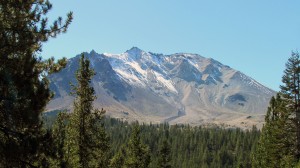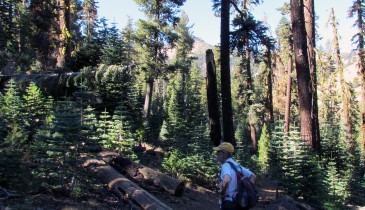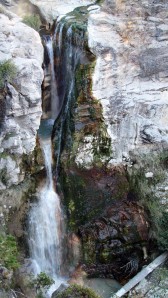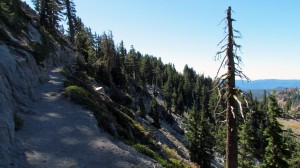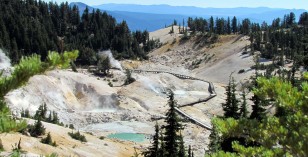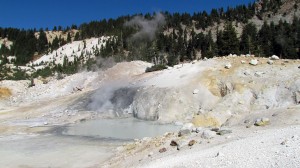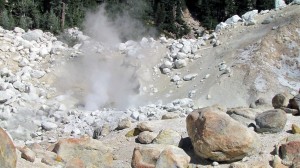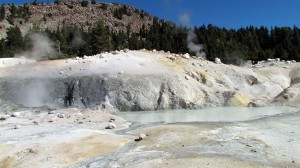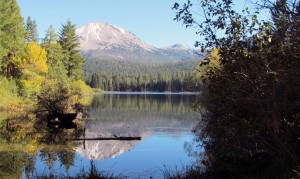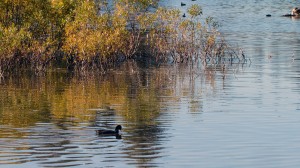Early October proved to be an ideal time to visit Lassen Volcanic National Park. Being a bit off the beaten tourist path with relatively low visitation, this park offers the chance to enjoy nature very nearly in solitude. The weather was crisp and clear and perfect for hiking.
Even though at first glance, Lassen Volcanic National Park appears to be simply another beautiful mountain area, it is unique in several ways. The park contains all the thermal features of Yellowstone except for geysers. All four types of volcanoes found in the world exist within Lassen Volcanic National Park – composite volcanoes, cinder cone volcanoes, shield volcanoes, dome volcanoes. Each of these volcanoes erupt different types of lava and form in different ways.
Arriving in mid-afternoon, we started our exploration of the park at the Kohm Yah-mah-nee Visitor Center where we picked up park information and hiking maps. After the ranger assured us that the Mill Creek Falls trail was a good one with only about 250 feet elevation change, we set off. He was correct about it being a good trail but what he neglected to tell us was that there may have been only 250 feet elevation difference from the high point to the low but there were numerous ups and downs in between so total change was much greater. It was also a bit longer according to the trail signs than indicated on the trail map. However, once you’re committed to a destination, it’s hard to give it up. So we kept going. Mill Creek Falls was very pretty and was worth it but, because of the drought of the past two years, not as impressive as we imagine it usually would be.
Mill Creek Falls Trail
Lassen Peak, one of the world’s largest plug dome volcanoes, most recently erupted from 1914 to 1917. In late May 1914 a burst of steam arose off the summit. On June 14, 1914, Benjamin Franklin Loomis, a local businessman and amateur photographer, and his wife camped near Manzanita Lake with their bulky camera equipment hoping to record an eruption. At 9:43 a.m. the mountain rocked with a fresh eruption and Loomis captured the unfolding event in a series of dramatic photos on glass plates. At the same time, three men were hiking the summit to “see what was going on” in the crater. Amazingly, they all escaped alive.
Although Lassen has remained outwardly quiet for nearly a hundred years, evidence of volcanic life remains. The lively thermal areas indicate the existence of an active magma chamber below the surface.
In 1864, Kendall Vanhook Bumpass, a well-known hunter and mountain man, discovered Bumpass Hell, the largest hydrothermal feature in the park. Originally Bumpass filed a claim with the intention of exploiting the area for its mineral and tourist value. While leading a group of tourists, Bumpass accidentally stepped through the thin crust, suffered a severe burn, and eventually lost his leg. This tended to squelch the enthusiasm for tourist visitation. The name Bumpass Hell remains as a warning against careless wandering in the most active hydrothermal feature in the park.
Today there is a good trail to Bumpass Hell which does include a steep descent and the resulting steep climb back out. The park service has erected numerous boardwalks so tourists can get relatively close to the thermal features without the misfortune that befell Bumpass himself. The mud-pots, fumaroles, and boiling springs continue to fascinate.
Another failed effort to exploit the natural resources of the region was made by Mathias Supan, who in 1865, began extracting sulfur from the area now known as Sulphur Works and developed a variety of “mine medicine” products which did not prove profitable. Later the area was promoted as a spa area, Sulphur Works Inn, which included a bathhouse, overnight cabins and a dining hall. Perhaps the smell of rotten eggs (hydrogen sulfide) was a bit discouraging to tourists?
Manzanita Lake was formed about 300 years ago when a nearby volcanic dome collapsed creating a horizontal avalanche which dammed up a creek. Manzanita Lake anchors the park road on the northwest and offers all tourist facilities as well as magnificent views. We were about to leave the park when I told Tom, “l bet if I’d walk around the end of the lake there, I’d get a good picture but maybe I have enough already.” His reply was that it might be the best picture of the day so off I went. He was so right – I got wonderful photos of Manzanita Lake with Lassen Peak in the background.
Lassen Peak and Cinder Cone became national monuments in 1906. B.F. Loomis’ photos and eyewitness descriptions of the eruptions in 1914 helped focus attention on Lassen and contributed to the establishment in 1916 of Lassen Volcanic National Park.
One of the park rangers told us that outside the park were lava tubes, dubbed the Subway Cave, which you could go through. It was a self-guided hike which required a flashlight and a jacket and was open 24/7. Since Tom is a spelunker at heart his interest was greatly piqued. Being open 24/7 really was a moot point as it was pitch dark inside the tube so it didn’t matter if it was daylight out or not. The tube was much larger than we anticipated and the floor was very rough and uneven. We can now say that we have hiked through a lava tube!
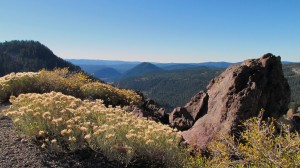 Viewpoint in Lassen Volcanic National Park
Viewpoint in Lassen Volcanic National Park
For more information:


